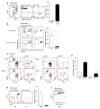Cutaneous immunosurveillance and regulation of inflammation by group 2 innate lymphoid cells
- PMID: 23603794
- PMCID: PMC4282745
- DOI: 10.1038/ni.2584
Cutaneous immunosurveillance and regulation of inflammation by group 2 innate lymphoid cells
Abstract
Type 2 immunity is critical for defense against cutaneous infections but also underlies the development of allergic skin diseases. We report the identification in normal mouse dermis of an abundant, phenotypically unique group 2 innate lymphoid cell (ILC2) subset that depended on interleukin 7 (IL-7) and constitutively produced IL-13. Intravital multiphoton microscopy showed that dermal ILC2 cells specifically interacted with mast cells, whose function was suppressed by IL-13. Treatment of mice deficient in recombination-activating gene 1 (Rag1(-/-)) with IL-2 resulted in the population expansion of activated, IL-5-producing dermal ILC2 cells, which led to spontaneous dermatitis characterized by eosinophil infiltrates and activated mast cells. Our data show that ILC2 cells have both pro- and anti-inflammatory properties and identify a previously unknown interactive pathway between two innate populations of cells of the immune system linked to type 2 immunity and allergic diseases.
Figures







Comment in
-
Regulatory roles of dermal type 2 innate lymphoid cells.Cell Mol Immunol. 2013 Nov;10(6):453-5. doi: 10.1038/cmi.2013.34. Epub 2013 Aug 12. Cell Mol Immunol. 2013. PMID: 23934029 Free PMC article. No abstract available.
References
-
- Bieber T. Atopic dermatitis. N Engl J Med. 2008;358:1483–1494. - PubMed
-
- Li M, et al. Induction of thymic stromal lymphopoietin expression in keratinocytes is necessary for generating an atopic dermatitis upon application of the active vitamin D3 analogue MC903 on mouse skin. The Journal of investigative dermatology. 2009;129:498–502. - PubMed
-
- Spits H, et al. Innate lymphoid cells - a proposal for uniform nomenclature. Nature reviews Immunology. 2013;13:145–149. - PubMed
-
- Mjosberg JM, et al. Human IL-25- and IL-33-responsive type 2 innate lymphoid cells are defined by expression of CRTH2 and CD161. Nature immunology. 2011;12:1055–1062. - PubMed
Publication types
MeSH terms
Substances
Grants and funding
LinkOut - more resources
Full Text Sources
Other Literature Sources
Molecular Biology Databases

